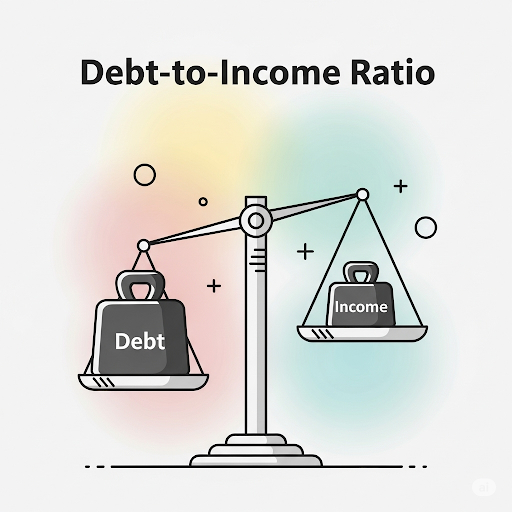Do you have student debt? Are you dreaming of buying a home of your own?
If so, you're not alone—and you're not out of luck. Many potential homeowners worry that student loans will keep them from qualifying for a mortgage or saving for a down payment. But the truth is, buying a home with student debt is possible—you just need the right strategy.
In today’s blog post, I’ll break down 8 key things you need to consider if you're planning to buy a home while still paying off your student loans. From understanding your debt-to-income ratio to finding first-time buyer assistance programs, this guide will help you navigate the homebuying process with confidence.
1. Understand Your Debt-to-Income (DTI) Ratio
One of the first things mortgage lenders look at is your debt-to-income ratio (DTI)—and when you have student loans, this number becomes even more important.
So, what is DTI?
Your DTI is the percentage of your gross monthly income that goes toward debt payments. This includes student loans, car payments, credit cards, and the projected mortgage payment. Lenders use it to assess your ability to manage monthly payments on top of a new home loan.
Example:
If you make $5,000 a month and pay $1,500 toward debts (including an estimated mortgage), your DTI would be 30%.
Why it matters:
Most lenders prefer a DTI under 43%, but aiming for 36% or lower improves your approval odds and access to better interest rates. If your student loans push you over that limit, it can hurt your chances of qualifying—or limit how much home you can afford.
How to improve your DTI:
-
Consider switching to an income-driven repayment plan for your student loans
-
Avoid taking on new debts before you apply for a mortgage
-
Increase your income (e.g., side hustle, promotion, co-borrower)
-
Pay down high-interest debts like credit cards first
Pro Tip:
Some loan programs, like Fannie Mae’s HomeReady®, allow lenders to use your actual student loan payment—even if it's reduced through an income-driven plan—which can help lower your DTI on paper.
What does this mean in practice?
Let’s say you owe $50,000 in federal student loans. If a lender uses the standard 1% of your balance to calculate your monthly student loan payment (which some mortgage programs do), that would be $500/month added to your DTI—even if you're only paying $150/month on an income-driven repayment plan.
That $500/month could make a huge difference in whether you qualify for a mortgage—or how much you qualify for.
Fannie Mae’s HomeReady® loan (and some other conventional loans) takes a more flexible approach. If you're on an income-driven repayment plan (IDR), lenders are allowed to use your actual monthly payment, even if it’s lower than the standard calculation—as long as it’s more than $0.
Example:
Instead of counting $500/month, the lender can use your actual $150/month payment in the DTI calculation. This lowers your overall DTI ratio, which can:
-
Help you qualify more easily
-
Allow you to afford a higher-priced home
-
Possibly get you a better interest rate
Important Note:
Some lenders still default to the 1% rule or may not be familiar with these guidelines, so it’s important to work with a loan officer who understands how to use student loan-friendly programs like HomeReady® or Freddie Mac’s Home Possible®.
2. Choose the Right Mortgage Loan Program
When you’re buying a home with student debt, the type of mortgage loan you choose can make a huge difference in how your student loans are treated—and whether you qualify at all.
Different loan programs have different rules for how they calculate student loan payments in your debt-to-income ratio (DTI), and some are much more forgiving than others.
Key Loan Programs to Know:
✅ FHA Loans (Federal Housing Administration)
-
Great for first-time buyers with lower credit scores (as low as 580)
-
Allows a DTI up to 56.9% in some cases
-
For student loans: If your monthly payment is above $0, the lender uses the actual payment. If it's $0 (e.g., you're in deferment), they may use 0.5% of the loan balance as an estimated monthly payment.
✅ Fannie Mae HomeReady®
-
Designed for low- to moderate-income buyers
-
Allows the use of actual student loan payments from income-driven plans, even if they’re under 1% of the total loan balance
-
Low down payment option (as little as 3% down)
✅ Freddie Mac Home Possible®
-
Similar to HomeReady®, with flexible guidelines for student loans and low-income buyers
-
Also accepts actual monthly student loan payments for DTI calculations
-
3% down and allows co-borrowers who don’t live in the home (helpful if parents are co-signing)
✅ USDA Loans
-
Available in rural and some suburban areas
-
0% down payment required
-
Uses 0.5% of the loan balance for student loan DTI, or the actual payment if it fully amortizes the loan
✅ VA Loans (for Veterans and Active Duty Military)
-
0% down, no private mortgage insurance (PMI), and favorable DTI guidelines
-
Most flexible for student debt—often accepts actual payments or even excludes student loan debt in some cases
Why this matters:
Choosing a loan program that treats student loan debt more leniently could be the difference between qualifying for a mortgage—or not. It can also impact your interest rate, down payment requirement, and how much home you can afford.
Pro Tip:
Work with a mortgage lender who’s experienced in working with buyers who have student debt. They’ll know which programs best fit your situation—and how to present your application in the best light.
3. Improve Your Credit Score Before You Apply
If you’re carrying student debt, a strong credit score can be your biggest asset when buying a home. While your debt-to-income ratio shows your current obligations, your credit score shows how well you manage them—and lenders take both into account when deciding whether to approve your mortgage and what interest rate to offer.
Why Your Credit Score Matters:
-
A higher score can offset the risk of carrying student loans.
-
You’ll qualify for lower interest rates, which can save you tens of thousands over the life of your loan.
-
Many loan programs have minimum credit score requirements (e.g., 580 for FHA, 620 for most conventional loans), but the best rates usually go to those with scores of 740+.
Quick Ways to Boost Your Credit Score:
✅ Pay Down Credit Card Balances
Your credit utilization ratio (how much of your available credit you're using) should ideally be below 30%. If possible, get it under 10% for a noticeable score boost.
✅ Make All Payments On Time
Payment history is the biggest factor in your credit score. One missed payment can cause a big drop—especially if it’s recent.
✅ Don’t Open New Credit Right Before Applying
New credit inquiries can temporarily lower your score, and new debt can increase your DTI.
✅ Check Your Credit Report for Errors
You’re entitled to a free credit report each year at AnnualCreditReport.com. Review it for inaccuracies that might be dragging your score down.
✅ Keep Old Accounts Open
The length of your credit history matters. Don’t close older accounts unless absolutely necessary.
Pro Tip:
Even a 20- to 40-point increase in your credit score can open up new loan options and significantly lower your mortgage payment. Consider using a free credit monitoring tool to track your progress as you get mortgage-ready.
4. Take Advantage of Connecticut First-Time Homebuyer Programs
If you’re buying your first home in Connecticut and juggling student loan debt, you don’t have to go it alone. The state offers several first-time homebuyer assistance programs that can help with down payment, closing costs, and even securing a competitive mortgage rate.
These programs are specifically designed for buyers who might not have large savings—but are ready to take the next step toward homeownership.
🏡 Key Connecticut Homebuyer Programs to Know
CHFA (Connecticut Housing Finance Authority)
CHFA is the primary resource for first-time buyers in Connecticut. Here’s how they help:
-
Low-Interest Mortgages: Below-market rates for qualified first-time buyers
-
Down Payment Assistance Program (DAP): Offers loans of up to $20,000 to help with down payment and closing costs (repayable over time, often with low interest)
-
Time To Own – Forgivable Loan Program: Offers up to $50,000 in down payment assistance that may be forgiven if you live in the home for 10 years
-
Target Area Benefits: Extra perks if you’re buying in a designated “target area,” including no need to be a first-time buyer and higher income limits
💡 Who Qualifies?
-
You must be a first-time homebuyer (or not have owned in the past 3 years)
-
Meet income and purchase price limits (varies by town)
-
Must complete a homebuyer education course
-
Home must be your primary residence
You can check eligibility and income limits by town on the CHFA website.
🏦 Pro Tip:
Many lenders in Connecticut are CHFA-approved, so ask your mortgage lender if they work with these programs. A good local lender can walk you through both CHFA and additional city-specific grants (like those offered by Hartford or New Haven).
Using Connecticut’s homebuyer resources can reduce the pressure of student debt and help you afford your first home—without waiting years to save up.
5. Consider Income-Driven Repayment Plans for Your Student Loans
If your student loan payments are high and making it harder to qualify for a mortgage, switching to an income-driven repayment (IDR) plan could be a game-changer—especially when it comes to reducing your debt-to-income (DTI) ratio.
💡 What Are Income-Driven Repayment Plans?
IDR plans are federal student loan repayment options that adjust your monthly payment based on your income and family size. There are several types, including:
-
SAVE (Saving on a Valuable Education) Plan – Replaced REPAYE
-
PAYE (Pay As You Earn)
-
IBR (Income-Based Repayment)
-
ICR (Income-Contingent Repayment)
These plans often lower your monthly student loan payment—sometimes significantly.
💰 Why It Matters for Homebuyers:
Lower monthly payments = lower DTI
Even if your loan balance is high, lenders often look only at your monthly payment when calculating your DTI. If you're on an IDR plan, your actual payment might be a fraction of the standard 10-year repayment amount.
Example:
You owe $60,000 in student loans. A standard 1% rule would estimate your monthly payment at $600. But on an IDR plan, your payment might be $200—which can make a huge difference in qualifying for a mortgage.
✅ Things to Keep in Mind:
-
You must recertify your income annually to stay on the plan.
-
Your total loan balance may grow over time, but mortgage lenders care more about your monthly payment than the total amount.
-
Not all loan programs recognize IDR plans the same way—so choose a lender who understands how to apply them (e.g., with HomeReady®, Home Possible®, or FHA loans).
🏡 Pro Tip:
Apply for an IDR plan before you start the mortgage pre-approval process. That way, your lender can use your lower payment to calculate your DTI and potentially approve you for more house—or approve you at all.
Using an income-driven repayment plan won’t erase your student debt, but it can make homeownership more accessible, even if your loan balance seems overwhelming.
6. Save Strategically for Your Down Payment
While managing student loan payments can feel like a significant hurdle, diligently saving for a down payment is still a critical piece of the homeownership puzzle. Even small, consistent contributions can add up over time and demonstrate financial discipline to lenders. Here are some strategic saving approaches to consider:
- Maximize High-Yield Savings Accounts: Take advantage of the higher interest rates offered by online or credit union savings accounts compared to traditional brick-and-mortar banks. Every little bit of extra interest earned can accelerate your savings.
- Automate Your Savings: Set up automatic transfers from your checking account to your savings account each payday. Even a small, recurring amount can become a substantial sum over months or years. Treat it like any other essential bill.
- Capitalize on Windfalls: Be intentional about saving unexpected income like tax refunds, annual bonuses, or even monetary gifts. Resist the urge for immediate spending and direct a portion (or all) of these funds toward your down payment.
- Cut Unnecessary Expenses: Review your monthly spending and identify areas where you can realistically cut back. Even small daily savings, like reducing takeout coffee or entertainment costs, can free up funds for your homeownership goal. Consider using budgeting apps to track your spending and identify opportunities for savings.
- Explore Down Payment Assistance Programs: Beyond the state-level programs that have been already mentioned, research local initiatives or grants specifically designed to help first-time buyers with down payment funds. Sometimes, cities or counties have their own programs with specific eligibility criteria.
By adopting a strategic and consistent saving approach, you can build a solid down payment fund even while managing your student loan obligations. This not only strengthens your mortgage application but also reduces the overall amount you need to borrow.
7. Consider Co-Buying or Utilizing a Co-Signer
If your individual financial situation is stretched due to student loan debt, exploring the possibility of co-buying a home with a partner or utilizing a co-signer could significantly improve your application strength and make homeownership more attainable.
- Co-Buying: Purchasing a home with a spouse, partner, family member, or even a close friend can pool your financial resources. This can lead to a larger down payment, a more comfortable debt-to-income ratio, and potentially access to a wider range of properties. However, it's crucial to have open and honest conversations about finances, responsibilities, and exit strategies before entering into a co-buying agreement.
- Co-Signer: A co-signer is typically a family member with a strong credit history and stable income who agrees to be jointly responsible for the mortgage. Their creditworthiness can help you qualify for a loan you might not be able to obtain on your own or potentially secure a better interest rate. Keep in mind that being a co-signer is a significant financial commitment for that individual, and it's essential to have a clear plan for how you will eventually take over the mortgage independently.
Carefully weigh the pros and cons of both options and ensure all parties involved fully understand the implications and responsibilities before moving forward.
8. Work with a Realtor and Lender Who Understand Your Situation
Navigating the complexities of buying a home with student loan debt requires the guidance of experienced professionals who understand the nuances of your situation.
Choosing a knowledgeable real estate agent and mortgage lender can make a significant difference in finding the right path and securing the best possible outcome.
- A Student Debt-Savvy Realtor: Look for a real estate agent who is familiar with working with first-time homebuyers and those carrying student loan debt. They can help you identify properties within your budget, negotiate effectively, and connect you with lenders who are understanding of your financial landscape. They can also be a valuable resource for local first-time buyer programs and navigating the Connecticut housing market.
- A Mortgage Lender Experienced with Student Loans: It's crucial to partner with a mortgage lender who is well-versed in the various loan programs (like FHA, HomeReady®, and Home Possible®) and how they treat student loan debt in the qualification process. They can help you understand your DTI, explore different loan options that align with your financial situation, and guide you through the pre-approval and application process with clarity and expertise. Don't hesitate to interview a few lenders to find one who is knowledgeable and communicative.
By partnering with a real estate agent and mortgage lender who understand the unique challenges and opportunities of buying a home with student loan debt, you'll have trusted advocates by your side, increasing your chances of a successful and less stressful home-buying journey.
Your Dream Home is Within Reach
Buying a home with student loan debt might seem daunting, but as we've explored, it's entirely achievable with the right knowledge and a strategic approach.
By understanding your debt-to-income ratio, exploring flexible loan programs, boosting your credit score, and taking advantage of Connecticut's fantastic first-time homebuyer resources, you can confidently navigate the path to homeownership. Remember that consistent saving and considering options like co-buying can also open doors.
The most crucial step is to connect with experienced professionals who understand the intricacies of your situation. A knowledgeable real estate agent and a mortgage lender familiar with student loan considerations can be your greatest allies in this journey.
If you're a fellow Connecticut resident dreaming of owning your own home despite student loan debt, please don't hesitate to reach out! I'm here to help you get started and explore the possibilities.
Thank you for joining me today. Be sure to check back weekly for fresh, new content packed with insights and advice to guide you on your homeownership journey!






.png)